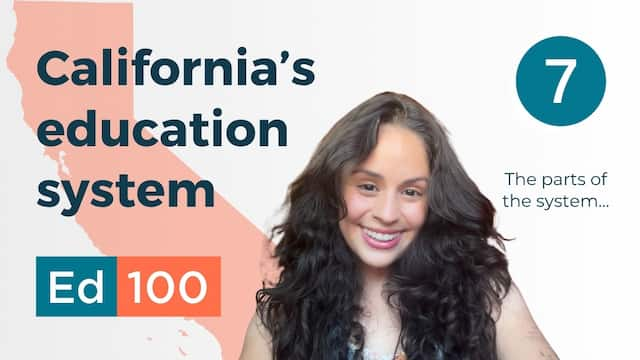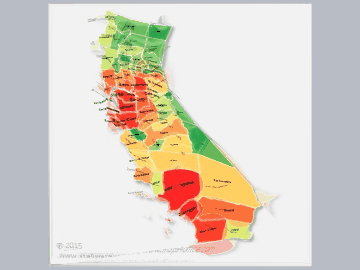
School districts in California have a great deal of authority.
In This Lesson

What is a county office of education?
What do county offices of education do?
How are school district boundaries formed?
How are county school board members selected?
Who reviews and approves our district's LCAP?
▶ Watch the video summary
★ Discussion Guide
School districts manage money and hire people. They set the strategy for how their schools will accomplish educational goals, and measure results, for example using the Local Control Accountability Plan (LCAP). But who oversees the school districts? Who in the system is formally charged with reading LCAPs with an informed and critical eye? And what happens when a challenge is too big for a school district to handle alone?
That's where county offices of education (COEs) come in. By forming partnerships with other local agencies and organizations, county offices can help school districts accomplish things that would be difficult or expensive to do alone, such as:
- Develop professional development programs for teachers, principals, and other school staff;
- Operate special programs for students (e.g. internships, concurrent enrollment at community colleges, service learning projects);
- Develop a robust parent education program;
- Craft partnerships with local business leaders; and
- Support family services on school campuses.
School district boundaries don't match city boundaries
In California, the boundaries of counties, cities, towns, and school districts often don’t match. The state's earliest county maps were inked in the gold rush era following 1849, and the last significant modification happened in 1907. Although it is rare for a school district to overlap a county line, it can happen.
Each of California’s 58 counties has its own County Office of Education (COE) and these offices play a huge variety of roles. You'll find county level information on the Education Data Partnership website. If you want to understand the details of districts and their boundaries in your area, the expert you are looking for probably works in a county office.
The role and scope of these county offices depend in part on the number of people they serve. Normal maps don't do a very good job of communicating how many people live in each county, so we created one that stretches to represent the relative population:

As you can see, California’s counties range from tiny to Los Angeles, which has a population so huge that if it were a state it would be America's 11th largest. In seven counties, most notably San Francisco, the county and school district boundaries are the same.
Most County Superintendents are elected.
All county offices are administered by a superintendent and governed by a board. In most cases, these positions are elected. In four counties, the County Board of Education appoints the county superintendent. County boards of education are separate from the county board of supervisors in every county except Los Angeles. And yes, of course there is a state organization of county superintendents of education, known as CCSESA.
What does the county office of education do?
County Offices of Education review and approve district budgets and LCAPs.
Most county offices provide at least some direct services to their local school districts. Some also manage special statewide projects. For example, the state’s Fiscal Crisis and Management Assistance Team (FCMAT) operates out of the Kern County office. The state Collaborative for Educational Excellence (CCEE) operates out of the Marin county office. Some of the state's smallest school districts, also known as direct service districts, outsource most or all of their business office functions to their local county office.
Video courtesy of Orange County Office of Education.
Most county offices also operate some education programs that provide services directly to students. Typically, these are special education programs for students with specific disabilities such as blindness or deafness, schools for students who have been expelled, and court schools for juvenile offenders. About half of the state’s county offices run Regional Occupational Centers/Programs (ROC/Ps) that provide Career Technical Education programs to youth and some adults. Some county offices manage training programs funded by the federal government as well as programs for Native American education (OIE) and Migrant Education (MEP).
By law, county offices have various forms of oversight over local districts and charter schools. They include:
- Approve each district's annual budget and two interim financial reports.
- Ensure districts' sound fiscal operation, and take specific actions if a district may not be able to meet its financial obligations.
- Monitor the quality of school facilities, instructional materials, and teachers.
- Support the work of the County Superintendent of Schools in reviewing and approving each district's Local Control Accountability Plan (LCAP).
County Offices of Education review district LCAPs to enforce equity
In 2014, county offices were given new responsibility as part of the shift to the Local Control Funding Formula. County superintendents must assure that local school districts’ Local Control Accountability Plans (LCAPs) are prepared properly and that a district’s budget is sufficient to implement the improvement strategies outlined in its LCAP.
Although County Offices of Education are the most prominent entities that affect students and schools, there are some other official agencies organized regionally, including Workforce Development Boards, First 5 agencies that support early education, and community colleges.
The next lesson turns to a sometimes contentious part of the school system: teachers unions.
This lesson was updated in July, 2025.
CHAPTER 7:
And a System…
-
And a System…
Overview of Chapter 7 -
The Role of State Government in Education
California’s Constitutional Responsibility -
The Federal Government and Education
Small money, Big Influence -
School Districts in California
What do School Districts Do? -
County Offices of Education
Oversight and Regional Services -
Teachers' Unions in California
What do Teacher Unions Do? -
Ballot Initiatives and Education
California's Initiative Process and How It Affects Schools -
Who Influences Education?
Politics, Philanthropy and Policy -
Accountability in Education
Who Monitors the Quality of Schools? -
What to Do with Failing Schools
Interventions and Consequences in California -
The LCAP
Annual Plans for California School Districts
Related
Sharing is caring!
Password Reset
Search all lesson and blog content here.
Login with Email
We will send your Login Link to your email
address. Click on the link and you will be
logged into Ed100. No more passwords to
remember!















Questions & Comments
To comment or reply, please sign in .
Jamie Kiffel-Alcheh November 23, 2019 at 11:04 am
Andres Ceja May 12, 2025 at 10:10 am
francisco molina August 19, 2019 at 12:54 am
Susannah Baxendale February 17, 2019 at 2:49 pm
Jeff Camp February 9, 2017 at 11:44 am